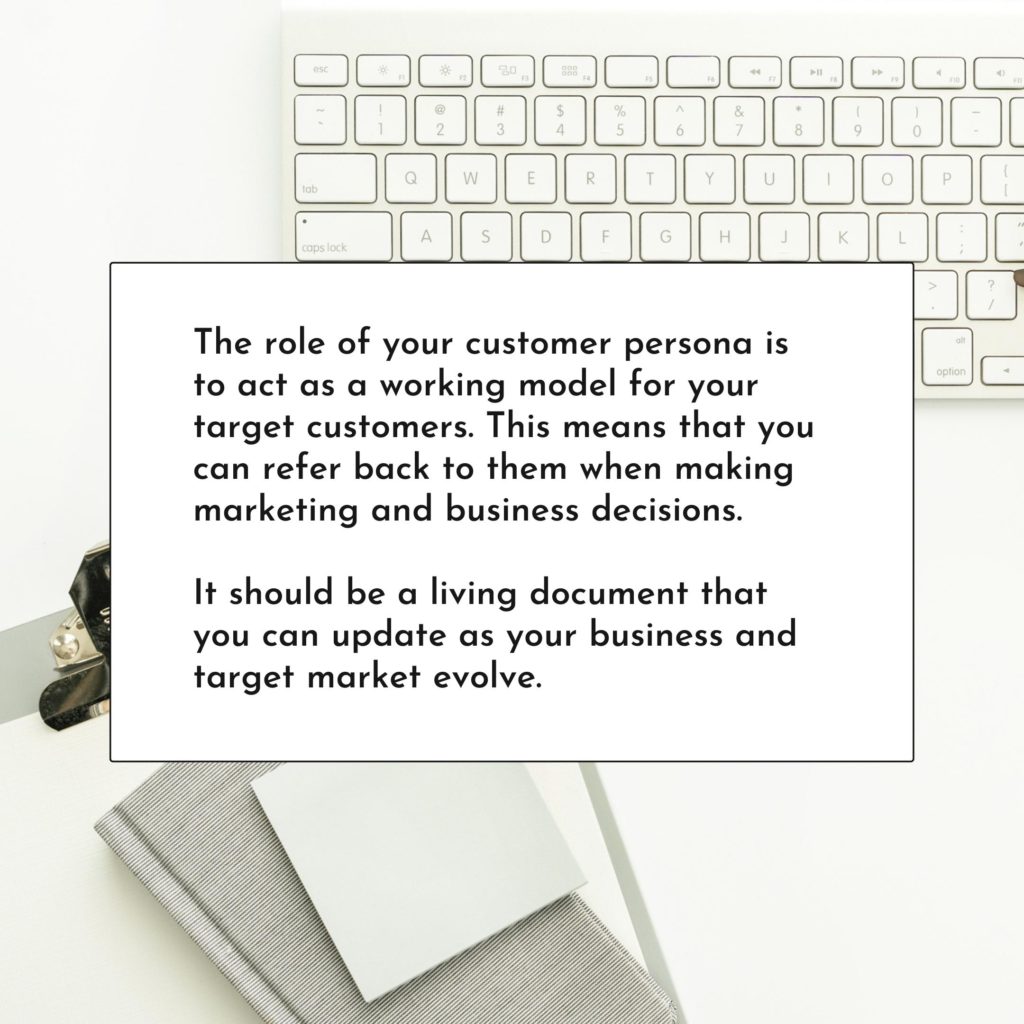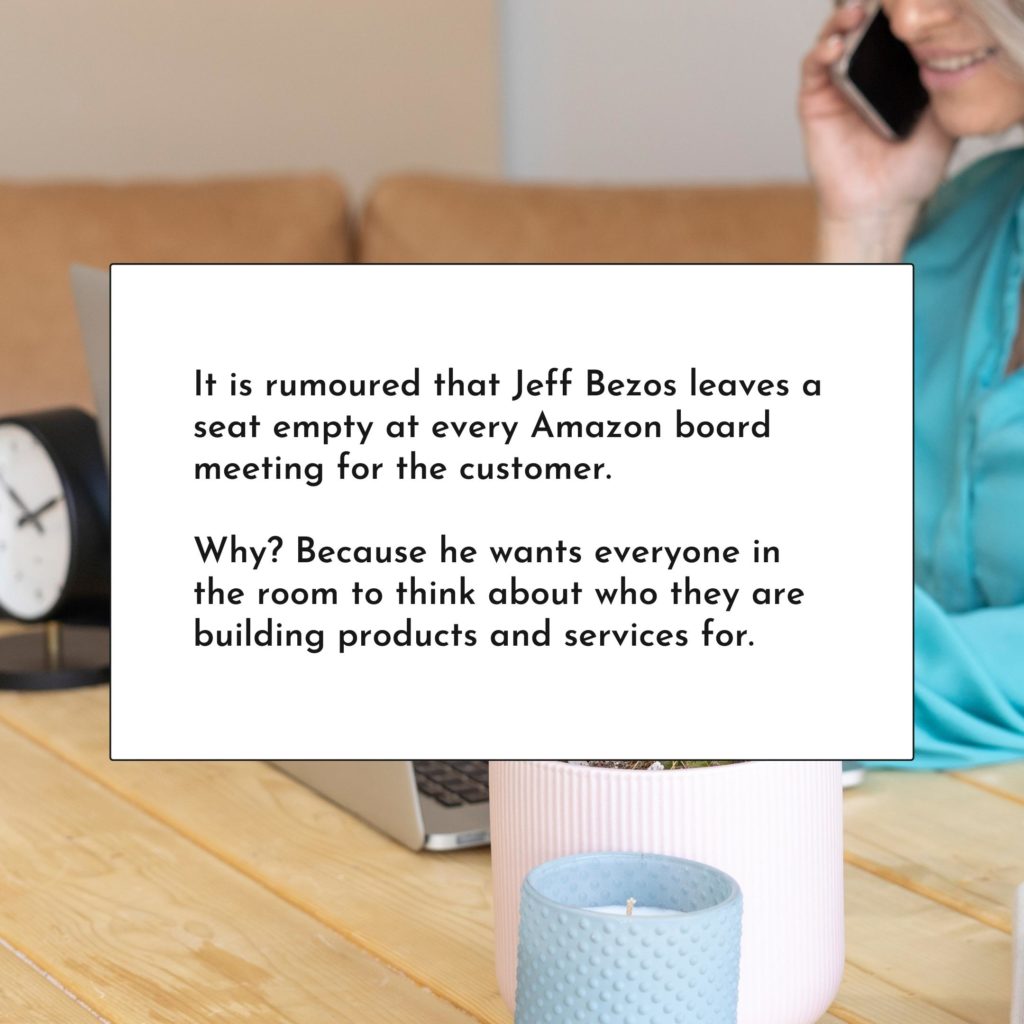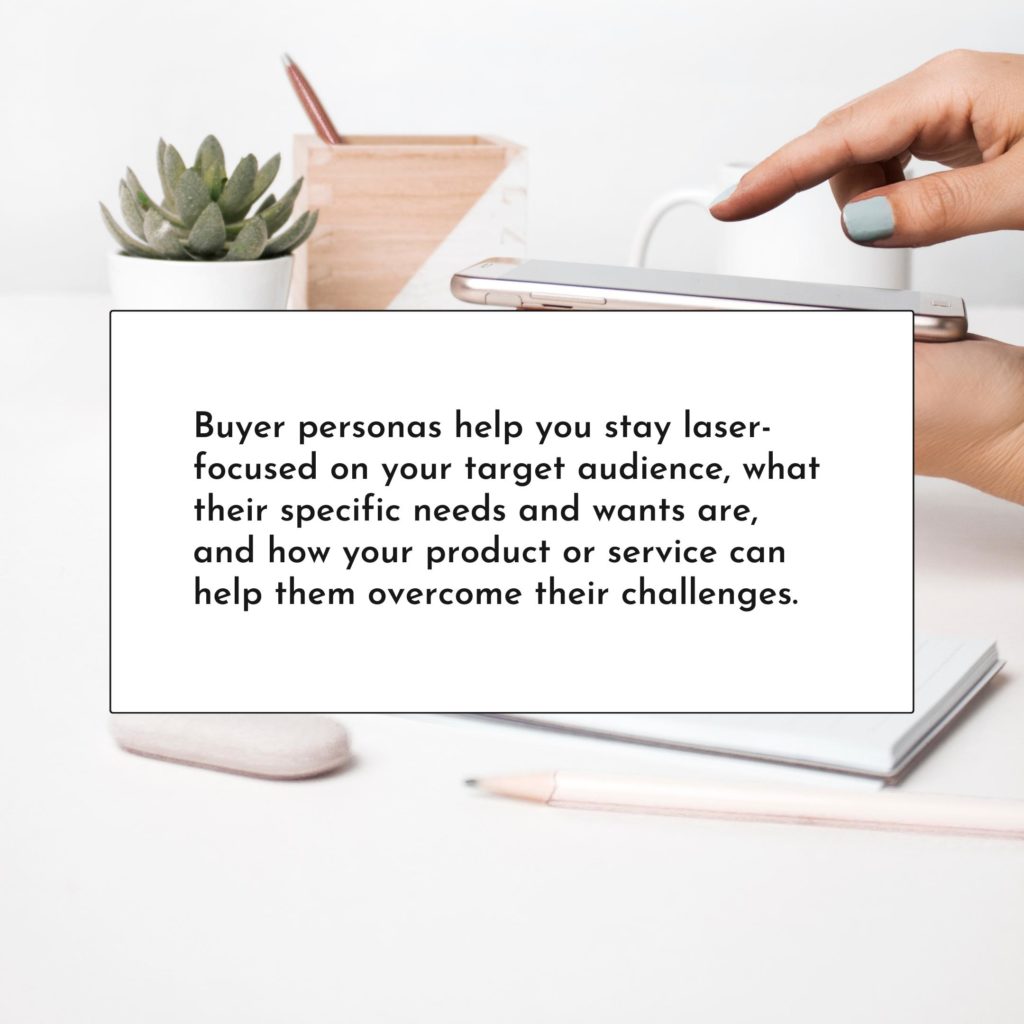It is rumoured that Jeff Bezos leaves a seat empty at every Amazon board meeting for the customer. Why? Because he wants everyone in the room to think about who they are building products and services for.
Placing your target customers at the heart of your marketing strategy is crucial for any business, yet so many organisations still don’t have a defined buyer persona. If you’re not sure where to start when it comes to creating yours, this post is for you.

Buyer Personas Explained
A buyer persona is a representation of your ideal customer. It includes demographic information such as age, gender, and income level, as well as psychographic information such as interests and hobbies. When you know who your ideal customer is, you can design your marketing strategy to appeal to them specifically.
Why use buyer personas?
Buyer personas help you stay laser-focused on your target audience, what their specific needs and wants are, and how your product or service can help them. When you know who your target market is, you can then tailor your marketing campaigns and sales process to reach them where they are and speak to them in a way that resonates.
Defining buyer personas will help you to better understand your target market, which is beneficial to sales and marketing teams, product development, and even customer service.
Marketing Teams
Once you know who your ideal customer is, you can design your marketing messages to appeal to them specifically. Marketing campaigns take on a new level of effectiveness when you know who you’re talking to.
Sales Teams
With detailed buyer personas, sales teams can target their efforts more effectively and close more deals. The sales process can be tailored to better address the customers’ pain points.
Product Development
When you know who your target market is, you can design your products and features to appeal to them specifically. This helps to ensure that your product meets the needs of your target market and results in fewer returns.
Customer Service
If you know who your target market is, you can design your customer service efforts to better address their needs. This can lead to happier customers and fewer support tickets.
Step 1: Define your customer base
The first step in creating a buyer persona is to define your customer base. You’ll likely need multiple buyer personas to represent the different segments of your customer base.
For example, if you sell building maintenance services to both trade and the general public, you’ll want to develop different buyer personas for each group. Map out the different segments of your customer base, and decide which one you want to focus on first.
When it comes to buyer personas, focus on your IDEAL customer as your target audience, as you will want to target your marketing messages towards attracting more customers like them.

Step 2: Research your customer base
The next step is to research your actual customers. Examine your sales data to see who is buying your products or using your services. Start by surveying your current customers—or even better, talking to them in person—to get an understanding of who they are, what they like and dislike, and what they hope to gain from using your product or service.
Talk to your sales team, customer service team, and anyone else who interacts with your customers on a regular basis.
When you research your customer base, you’ll want to look for commonalities. What do they have in common? What are their pain points? Which needs do they have that your product or service can address? This will help you create more accurate buyer personas.
As well as the standard demographic information, you’ll also want to try and uncover beneath the surface to really understand your persona’s motivations. A few ideas of points to cover include:
- What are they moving towards? For example, a healthier lifestyle that means they can run around after their children.
- What are they moving away from? For example, an unhappy job means they’re looking for a career change and need your coaching services.
- What motivates them? For example, a fear of failing or a desire to succeed.
- What challenges do they face? What are their pain points? For example, a lack of time or resources.
- What are their concerns? For example, anxiety about their retirement savings which means they need your financial planning services.
- Who influences their decision-making process? For example, their spouse or children, colleagues or online influencers.
By understanding these motivators, you can create buyer personas that are much more than just a list of demographics.
Look for patterns and trends among your existing customers. This will give you a good starting point for creating buyer personas that appeal to new potential customers.
Then, take to the internet and social media to see what people are saying about your brand, product, or service. Use social media listening tools and Google Alerts to stay up-to-date on what’s being said about your brand online.
You can also look at data from your website analytics and social media platforms. This will give you a better understanding of who your ideal target customer is and what they are looking for.
Step 3: Give your persona an identity
Once you have completed your buyer persona research, it’s time to give your buyer personas a name and a face. This will help you humanise your persona and make them easier to relate to.
When choosing a name, it makes sense to think about what would appeal to your prospective customers. If you are targeting corporate decision-makers, you might want to choose a name that sounds professional and trustworthy. If you are targeting young adults, you might want to choose a name that is trendier and more youthful.
To choose a face, you can either use a real person or create an illustration. If you use a real person, make sure to get their permission first. You can also find royalty-free photos of people that you can use.
When choosing a face for your persona, think about what kind of person your target customer would be attracted to. For example, if you are targeting young adults, you might want to choose a face that looks friendly and approachable.
If you are targeting corporate decision-makers, you might want to choose a face that looks more serious and professional.
Step 4: Create your buyer persona
Once you have gathered all of the information, you can now create your own buyer personas!
Remember, the role of your customer persona is to act as a working model for your target customers. This means that you can refer back to them when making marketing and business decisions. It should be a living document that you can update as your business and target market evolve.
For this reason, over-complicating your persona can actually do more harm than good. So, start with the basics and build up from there.
Your buyer personas should be:
- Accessible and easy to understand
- Free from marketing or sales jargon
- Based on customer research, not assumptions
- Straightforward and to the point
- Focused on a specific product or offering
What to include in your buyer personas
When creating your buyer persona, there are a few key elements that you should include:
Demographics – Age, gender, location, job title, etc.
Goals – What they hope to achieve by using your product or service.
Challenges – The problems they are facing that your product or service can help with.
Common Objections – The reasons why they might not buy from you.
How you can help – A summary of how your product or service will help them achieve their goals.
By including these key elements, you will be able to create a persona that is realistic and relatable.

Step 5: Implement your buyer personas in your business
Now that you understand the process of creating customer personas, it’s time to put them into action in your marketing strategies.
By having a well-defined buyer persona, you can make sure that your marketing and sales efforts are focused on the right people. This will lead to more qualified leads, and ultimately, more sales.
Keep your buyer persona in mind when creating content, designing products, and pricing your services. By doing this, you will be able to appeal to your ideal customer and make more sales.
Here are a few ideas of how your marketing and sales teams can use your buyer persona:
In your content marketing – Write blog posts, create infographics, or make videos that are relevant to your persona’s interests and needs.
In your social media marketing – Use social media listening tools to find out what topics your persona is talking about online. Then, create content that addresses their concerns.
In your paid advertising – Use demographic targeting to make sure your ads are only being shown to your persona.
In your email marketing – Write emails that are tailored to your persona’s interests and needs.
By using your buyer persona in your marketing, you can be sure that you are reaching the right people with the right message.
For your sales teams, your buyer persona can be used as a guide when talking to potential customers. By understanding the challenges and objections that your persona faces, your sales team can be better prepared to address them.
Buyer Persona FAQs
What makes a good buyer persona?
A good buyer persona should be grounded in reality. It should be based on data from surveys, interviews, and market research. It should also be specific enough to be useful, but not so specific that it’s impossible to find buyers that fit the persona.
How many buyer personas should a business have?
A business should have as many buyer personas as they have distinct types of buyers. If you’re selling to both businesses and consumers, you should have a separate persona for each.
If you’re selling different products or services to different types of buyers, you should have a persona for each type of product or service.
How often should I update my buyer persona?
You should update your buyer persona as often as it makes sense for your business, ideally at least every six months to ensure that it is timely and accurate. This way, you can change your marketing efforts as needed to appeal to your target market.
Who should I include in my buyer persona?
When creating your buyer persona, you should include information about their demographics, interests, and needs. You can also add a picture to give your persona a face.

What are some common mistakes when creating a buyer persona?
Some common mistakes include:
Not embedding them in the organisation – Many organisations that spend time creating personas fail to embed them fully in their marketing. As a result, they don’t get the full benefit of having a persona.
Failing to research your target market – It’s important to have a deep understanding of your target market before you create a persona. Otherwise, you run the risk of creating a persona that is not accurate.
Creating too many personas – You should only create as many personas as you need. Creating too many can be overwhelming and make it difficult to focus your marketing efforts.
Making assumptions about your customer base – When creating your persona, it’s important to avoid making assumptions about your customer base. Instead, base your persona on data from surveys, interviews, and market research.
Not including enough information – A persona should be specific enough to be useful, but not so specific that it’s impossible to find buyers that fit the persona.
Creating a static persona – A buyer persona should be a living document that is updated as your target market changes. Otherwise, it runs the risk of becoming outdated and inaccurate.
We hope this blog post was helpful in teaching you how to create a buyer persona for your business. If you have any questions, please feel free to leave a comment below or contact me at heather@hblackford.consulting.

Comments +